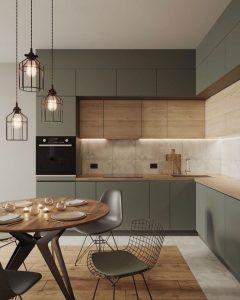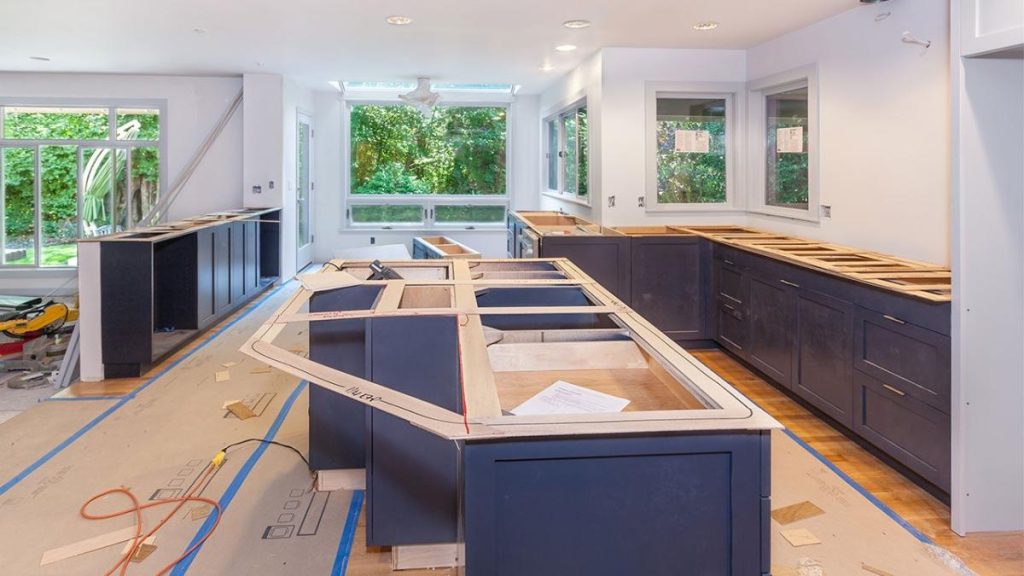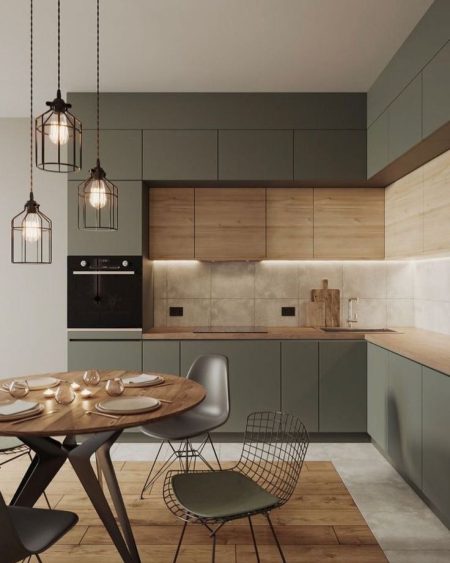Whether you’re looking to renovate your kitchen, install a home office or finish your basement, any major home improvement is going to require some major money.
You don’t have to wait until you have all the cash in hand, though. A home renovation loan could be your path to getting the project underway sooner than you think.
Key takeaways
-
There are multiple loan options for people who want to borrow money to improve or renovate their home.
-
Some options, including home equity loans and HELOCs, can have tax advantages.
-
Loans that don’t rely on home equity are also an option, but typically have higher rates.
-
Some government loans allow you to finance a home purchase and renovation simultaneously.
What is a home renovation loan?
A home renovation loan is a loan that includes funds for renovating, remodeling and repairing a home. It can be like a regular personal loan, but it often takes the form of mortgage with extra money for home improvements.
More specifically, a home renovation loan can be:
You don’t necessarily have to live in the home already; some home renovation loans can be used to buy a fixer-upper and make upgrades right away without the need to apply for separate financing.
Most home renovation loans require the borrower to have a certain amount of equity in the home (the main exception being personal loans).
When should you consider a home renovation loan?
If you don’t have enough cash on hand to finance remodels or repairs for your residence, a home renovation loan is worth considering. It’s also worth pursuing if you have your eye on a home that has a low asking price but needs serious work.
These loans can be a big boost for homeowners or buyers who want to build equity in their property by making improvements — but they’re generally only underwritten for substantial upgrades, not handyman or simple repair work. If a project will boost the fair market value or worth of the property, a home remodel loan can be a valuable tool.
“I would only recommend taking out a renovation loan if the costs of the renovation are still well below the current value of the home,” says Gregg Harris, president of LenderCity Home Loans in Chesterfield, Missouri. “It is also important that they will positively impact the value of the home over the long run. So, things like bathrooms, kitchens and additions make the most sense.”
Home renovation loan options
|
Loan type |
When to use |
Minimum credit score |
Additional considerations |
|---|---|---|---|
|
Fannie Mae HomeStyle |
For any project |
620 |
Renovation costs limited to 75% of expected value of the property after reno |
|
FHA 203(k) |
For many projects, but they can’t be luxury renovations and must be for your primary home |
580 |
Must be borrowing at least $5,000, and project must be completed within 6 months |
|
Home equity loan/HELOC |
For any project, but tax advantages if for the home |
Varies by lender |
Might pay extra fees to close, but interest rates tend to be competitive |
|
Cash-out refinancing |
For any project |
Varies by lender |
Need at least 20% equity to qualify, and must pay closing costs |
|
Personal loan |
For any project |
Varies by lender |
Some loans capped at $35,000; interest rates tend to be higher |
Fannie Mae HomeStyle Renovation loan
The Fannie Mae HomeStyle Renovation loan allows borrowers to either buy a place that needs repairs or to refinance their existing home loan and get money for improvements.
One advantage of a HomeStyle loan is that it’s a single debt with one monthly payment; you don’t have to take out a loan for the mortgage and another loan for home repairs. Getting one loan cuts down on time and closing costs.
The loan money goes into a separate escrow account that’s used to pay contractors. Borrowers do not have access to those funds.
The Fannie Mae HomeStyle loan can be used to improve a vacation home or investment property, and any renovation or repair is eligible for funding, as long as it’s permanently affixed to the property and adds value to it.
-
Pros
-
Homeowners can borrow money to improve their property. In this way, the loan is an investment that could boost the home’s value.
-
You can qualify with a down payment as low as 3 percent if you’re a first-time buyer getting a fixed-rate loan and you plan to live in the home.
-
May feature lower interest rates and shorter repayment terms than conventional improvement loans.
-
Conveniently includes the purchase of home’s principal and home renovation funds in one loan with one set of closing costs.
-
-
Cons
-
Renovation costs are limited to 75 percent of the “after-repaired value” of the home, with a 50 percent cap for manufactured homes.
-
Renovations must be completed within 12 months from the date your loan closes.
-
Borrowers can’t directly access funds.
-
There’s more onerous paperwork, and it usually takes longer for money to come through than with conventional loans.
-
-
Costs and fees
Despite financing both your home’s principal debt and renovation, the Fannie Mae HomeStyle refinance loan is only one loan with one set of closing costs.Fees and closing costs may be higher than other types of mortgage loans. However, through Fannie Mae’s Community Seconds program, you may be able to borrow up to 5 percent of your home’s value to help cover the down payment and closing costs.
-
Other considerations
In a competitive real estate market, a Fannie Mae HomeStyle Renovation loan may not be ideal if you’re looking to secure a deal fast. These loans require some additional work upfront before your loan is approved — and before you can even submit an offer on a home. For example, your contractor must establish a schedule for construction and plans for your renovation. Additionally, you must submit a property appraisal known as an “as- completed” appraisal.
FHA 203(k) loan
Like the Fannie Mae HomeStyle Renovation loan, the FHA 203(k) loan is a government loan that can simultaneously fund the purchase of a home and renovations under one mortgage loan.
There are two types of FHA 203(k) loans:
-
Limited 203(k) loans are capped at $35,000.
-
Standard 203(k) loans are for major rehabilitation or construction.
-
Pros
-
Income and down payment requirements are less stringent than other types of mortgage loans.
-
One mortgage covers the purchase of your home and renovations.
-
Includes minimal down payment, as low as 3.5 percent.
-
May be eligible for a larger tax deduction (the larger loan combines renovation and home purchase).
-
-
Cons
-
Mortgage Insurance Premium (MIP) is required.
-
Can be used for primary residence only.
-
Remodel limited to FHA’s list of eligible projects.
-
Involves more paperwork than other types of mortgage loans.
-
-
Costs and fees
Closing costs generally range from 3 percent to 6 percent of the purchase price.
-
Other considerations
If the process of getting an FHA 203(k) loan seems overwhelming, take comfort that a qualified 203(k) consultant will guide you every step of the way.
Also, as much as you want to get started remodeling the kitchen or another part of your home, the lender will require you to address all safety and health hazards first, such as lead-based paint, termites and broken windows.
The FHA 203(k) loan has a long list of eligible improvements, such as replacing a roof, flooring and plumbing, removing safety and health hazards and upgrading to accommodate a person living with a disability. However, the loan can’t be used for a luxury/purely discretionary improvement, such as building a backyard swimming pool or tennis court and the loan is only for primary homes, not second homes or vacation residences.
Home equity loan or HELOC
A home equity loan is a fixed-rate, lump-sum loan with monthly payments that remain the same for the loan term.
A home equity line of credit, or HELOC, has a credit limit and revolving balance. This loan works well for homeowners who have several large payments due over time on a big home improvement project.
Generally, you’ll receive one lump sum payment with a home equity loan, while HELOCs have a draw period of five to 10 years, during which you can access funds.
-
Pros
-
Competitive interest rates, especially compared to personal loans/credit cards
-
Home equity loans come with fixed interest rates and payment amounts that remain the same for the life of the loan.
-
With HELOC, funds draw as you need and only pay interest on what you draw.
-
You may be able to deduct the interest if you itemize on your tax return.
-
-
Cons
-
If you fail to make payments, the lender could foreclose on the home, as it backs the loan.
-
You can’t draw funds only as needed with home equity loans as you can with HELOCs.
-
Interest rates are variable with HELOCs, which means your rate and payment can increase.
-
Qualifications may be more stringent: You need to have and maintain a certain amount of home equity.
-
-
Costs and fees
Closing costs vary from 2 percent to 5 percent of the loan amount. A $50,000 loan might cost you between $1,000 and $2,500.
-
Other considerations
With your home serving as collateral, you might only consider a home equity loan L or HELOC if you expect you can comfortably repay the loan. A home equity loan is typically easier to add to your budget since the interest rates are usually fixed with the same monthly payment. By contrast, HELOC loans typically have variable interest rates that may fluctuate month to month.
If you borrow against your home equity to renovate your home, you can do pretty much any project you want, but you should consider whether the project will add to your home value. For example, new garage doors and a remodeled kitchen are considered high-impact upgrades that can help you recoup more of your investment when you sell.
Cash-out refinance
A cash-out refi allows homeowners to refinance their mortgage for a higher amount than the previous mortgage, based on how much equity they have, and take out the difference in cash. A cash-out refinance can have the double benefit of letting you refinance a higher-rate mortgage to one with a lower rate while pulling out cash to spruce up your property.
A refinance works well if you can get a lower rate than the one on your current mortgage. A lower interest rate and an increase in home value as a result of renovations are great long-term benefits.
-
Pros
-
Can use the refinance to fund home improvement projects, consolidate high-interest credit cards, or a variety of other purposes.
-
May be able to get a lower interest rate or change loan term.
-
The cash-out is included in the new mortgage, so there are no separate payments to make.
-
A portion of the cash-out interest may be tax-deductible.
-
-
Cons
-
You must use your home as collateral.
-
Must have at least 20 percent equity in your home to be eligible.
-
Closing costs can be high — similar to any refinance or new mortgage.
-
-
Costs and fees
Expect to pay about 2 percent to 5 percent of the new loan amount in closing costs.
-
Other considerations
Since a cash-out refinance involves taking out a new mortgage, you’ll have a new loan with new terms. If you select an adjustable-rate mortgage (ARM), your interest rate and monthly payment could change every month, quarter, year, three years or five years, depending on the adjustment period for your loan.
Personal loan
An option for those who can’t or don’t want to tap home equity is a personal loan from a bank, credit union or online lender. Unlike a refi or home equity loan, a personal loan is unsecured, so you don’t have to use your home or any other asset as collateral. Loan eligibility is based on your credit score, income and financial history.
Naturally, consumers with “very good” FICO credit scores of 740 and up get the best interest rates on personal loans, which can be below 6 percent APR. Some lenders extend personal loans to consumers with credit scores as low as 580, though the rates on those tend to be much higher. You can quickly find lenders and interest rate ranges through Bankrate.
If you’re eligible, you could be ready to move forward with your new kitchen, bathroom or another home project. Overall, the benefits and downsides of a personal loan include:
-
Pros
-
Interest rates are usually lower for personal loans than credit cards.
-
Consolidate debt from multiple high-interest credit cards into one loan with lower interest rates.
-
Funding can be as fast as the same day or the next business day.
-
Most personal loans are unsecured, meaning you won’t have to offer your home as collateral.
-
-
Cons
-
Typically have higher interest rates than home equity loans and HELOCS and cash-out refis (since the loan is unsecured).
-
You may incur several fees, such as a loan origination fee, prepayment penalty and an appraisal fee.
-
-
Costs and fees
These loans often include origination fees ranging from 2 percent to 5 percent.
-
Other considerations
You can reduce the amount of your debt by paying off high-interest credit card debt with a lower-interest personal loan. However, if you’re taking out a personal loan to pay for a large expense, you’ll increase your debt load, making it harder to qualify for credit products later on. Use Bankrate’s personal loan calculator to see how much a personal loan might cost you in interest.
Personal loans also give the borrower lots of leeway regarding the type of improvements that can be made. Lenders also have a lot of leeway regarding the amount of interest they can charge you, though. Simply put, if you’re borrowing money at a 25 percent interest rate, you’re going to pay far more than might be necessary to complete your project.
How to choose a home renovation loan
As you consider options for a renovation loan or a remodeling loan, here’s a rundown of how to get the best deal for your finances and the best fit for your needs.
1. Review your credit
Before applying for any loan, it’s important to remember that your credit plays a critical role in locking in the lowest interest rate. If you have time, consider taking steps to improve your score by paying down credit card bills and making all payments on time.
If your credit isn’t great and you have little money to put down, an FHA 203(k) loan might be best, since you can get a mortgage with only 3.5 percent down.
2. Estimate the cost of your project
What will your labor costs be? What about supplies? Will you need to rent a place to live elsewhere while the project is happening? Put together a comprehensive budget. The size of that number can help you understand which loan will be best, and you can also estimate your monthly payments.
3. Know how much equity you currently have
If you’re looking to renovate your existing home, take a look at your monthly mortgage statement to understand how much equity you have accrued.
“If a borrower has the ability to pull the money out of their home to pay for renovations via a cash-out refinance or a home equity loan or line of credit, the costs of obtaining money for the rehab or renovation would be less,” says Michael Becker, loan originator and sales manager at the Baltimore retail branch of Sierra Pacific Mortgage. “The problem with doing that is when you don’t have the equity in your home to pull out that cash.
“If doing the rehab will add value to your home and you don’t have much equity in your home as-is, then a 203(k) loan or Fannie Mae HomeStyle Renovation loan may be your only option,” Becker says.
4. Comparison shop
Just as you did with your mortgage — and just as you should do anytime you make any big financial decision — look at payment terms and fees from a few different lenders. Rates and costs vary from bank to bank, so do your research (and your math) to make sure you get the best deal. The only thing better than renovating your home is renovating it while knowing you’re getting a good deal on borrowing the money.
What to look out for when doing home renovations
While renovating your home may sound exciting, remember that these projects — and borrowing the money to make them a reality — can come with significant drawbacks.
Don’t let your upgrade come with any of these downsides:
-
Making an investment that isn’t worth the cost. Are you planning on selling this home in the near future? Don’t spend money on a house renovation that won’t increase the sales price of your home by a similar or greater amount.
-
Failing to account for extra costs. When considering renovations, keep in mind that the total cost will probably involve more than just labor and materials. The total often includes fees for architectural and engineering services, inspections and permits. Plus, you should expect the unexpected — additional costs, overruns, etc. — to pop up.
-
Being unrealistic about the timeline. Renovating a home is not a simple task. Consider the potential implications of delays in the project. If you’re renovating your kitchen, that means more take-out or dining out, both of which cost more than home cooking. If you’re renovating a bedroom, it could mean more time in a rental while you wait to move back in.
Additional reporting by T.J. Porter
Read the full article here









